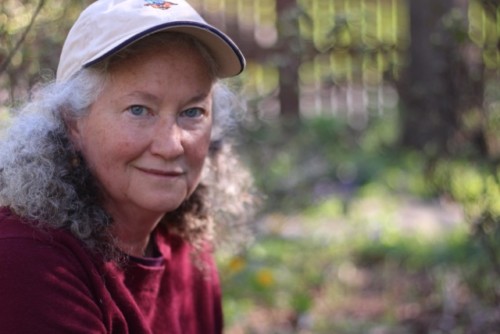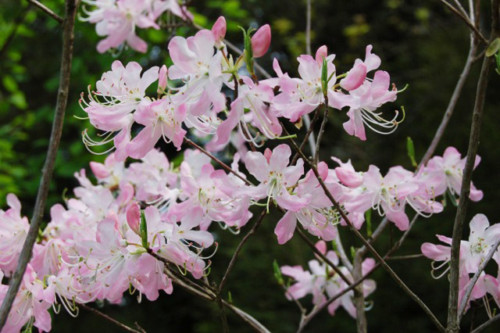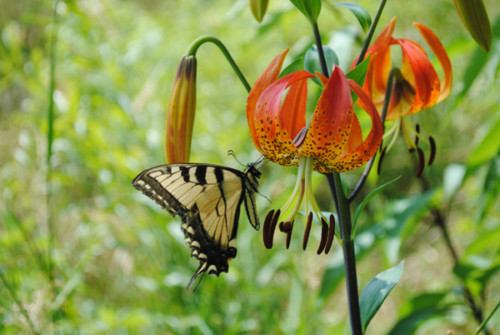Flying Trillium Gardens and Preserve is a Plant Paradise in the Catskills
When I was planning a weekend getaway to the southern Catskills, I heard about Flying Trillium Gardens and Preserve— a hidden oasis uniquely dedicated to the cultivation and protection of native plants of the Northeast.
Located in Sullivan County, NY just a few miles from the town of Bethel (the site of the famous 1969 Woodstock Festival), Flying Trillium is the brainchild of Carolyn Summers, a native plant landscape designer, teacher, and writer.
Summers and her husband David Brittenham purchased the property (a former 300-acre dairy farm) in 1997, building a stunning Adirondack-style home on a hilltop with panoramic views of Slide Mountain and other distant Catskill peaks. Since that time, as they are mostly in a Zone 5 Climate, Summers has been able to transform the area and create a truly inspiring paradise for native plants. Here is what one might find there:
Ice Age Kettle Hole Bog
As I drove up the long winding dirt road to the house, I saw some carefully-tended young trees, sweeping meadows bordered by original stone walls, and lots and lots of deer fencing. I passed by a local crew of mowers and weeders, and after driving through a few rustic twig gates, I was cheerfully greeted by Carolyn and her handsome dog, Bailey, who gleefully joined us for a walking tour.
Summers named the property for the many colorful varieties of Trillium, a prominent native plant, that can be found in the area. She explains, “Some of the purple trilliums grow along the side of steep rocky slopes. When I took a series of photos of them at different angles, they whimsically suggested little turbo prop airplanes taking off.”
We started out in the woodland part of the nature preserve. Summers points out that Flying Trillium is unique because it combines both designed gardens and a nature preserve– “the best of both worlds,” in her words.
One part of the preserve is the “Kettle Hole Bog,” where glaciers carved out a kettle-shaped hole thousands of years ago. I’d never seen one before. We walked on a raised, wooden, boardwalk towards the bog. On each side of the raised walk, an amazing array of tall, dense cinnamon ferns waved in the breeze.
We stopped to smell the lovely pink-colored azaleas, which are scented like cloves. Ahead was a charming twig bench and a view of the bog, which is filled with a wide variety of native plants including pitcher plants, cranberries, and bog laurel. (Summers says people have to take off their shoes and walk barefoot in the bog so as not to harm the delicate ecosystem.)
Eight Inspiring Demonstration Gardens
Summers grew up in the Adirondack region of New York State and studied landscape architecture in college. She says her early goal was to create landscapes for wildlife as well as people. “Early on,” she explains, “it became clear that native plants were the key to making that happen.”
Each of the eight demonstration gardens on the property gives homeowners– and especially landscape designers– the opportunity to become familiar with certain native plants while providing ideas for designing with them. One example: On a sunny slope near her swimming pool, Summers planted a sweep of blue eastern lupines (Lupinus perennis). They compliment the bluestone terraces surrounding the pool and attract many butterflies.
An old watering hole from dairy farm days is now filled with blue flag iris (Iris versicolor), a species that also lines other water gardens featured on the property.
Then there are the carefully-placed conifers. Junipers shaped like giant Bonsai are part of a stunning collection of dwarf conifers– over 75 different varieties.
When it comes to ornamental trees and shrubs, there’s a very practical, dome-shaped dwarf river birch (Betula nigra “Little King”) that would work well in a compact space. Or how about a red-flowered buckeye tree (Aesculus pavia)? It’s basically a giant hummingbird feeder.
“All of the demonstration gardens are designed to illustrate the beauty, diversity, and garden utility of native plants in traditional settings,” says Summers. As we spot butterflies hovering over her fragrant azaleas, she mentions that there are about 100 colorful azalea varieties in her collection.
Why Use Native Plants for Landscaping?
Summers prefers to call her plants “indigenous” rather than “native.”
“An indigenous plant is one that evolved over millennia in the same habitat in which it is currently found, so it’s more of a regional term, while the term “native” is more political or continental,” she notes. But as a practical matter, the terms are often used interchangeably and they have become increasingly important to gardeners, given Climate Change and the loss of wildlife habitat to suburban sprawl and development.
One of the main reasons to use native plants in home landscapes is that they host native bees, butterflies, moths, and other insects. Often these pollinating insects are “host specific,” meaning their larvae or caterpillars can only survive on a specific group of plants or a single plant. Some butterfly species like the Karner Blue butterfly, which is federally listed as endangered, and the much-loved Monarch butterfly, need certain native plants for their food. (See our previous coverage of Monarchs and milkweed plants.)
Summers also cites studies that show native bumblebees (Bombus sp.), like other indigenous bees, are “four more times more likely to take nectar and pollen from indigenous plants than from non-native plants.”
The Flying Trillium website thankfully lists many native bee and butterfly-hosting plants including: joe pye weed, turk’s cap lily, boneset, milkweed, woodland sunflower, bluebells and phlox, bee balm, and black-eyed susan.
Going Native
You can find out much more about designing native plant gardens by reading Summer’s book, [easyazon_link identifier=”0813547075″ locale=”US” tag=”gardcoll03-20″]Designing Gardens with Flora of the American East[/easyazon_link]. It has extensive, very useful plant lists that are organized by different garden designs, such as formal gardens, or Japanese and Chinese-style gardens.
Notable sections of the book have illustrations of non-native plantings and how to replace them with just-as-beautiful, insect-and bird-friendly native plants– a testament to Summers’ conviction that it is possible to go native and still have a lovely, traditional-style garden to enjoy.








































